

Organization – Office - Christopher Butler
source link: https://www.chrbutler.com/organization-office?ref=sidebar
Go to the source link to view the article. You can view the picture content, updated content and better typesetting reading experience. If the link is broken, please click the button below to view the snapshot at that time.

Organization — Office
After the kitchen, the office is the most used room in our home. This is how we keep it organized.

This is the office.
My wife and I work here, Monday through Friday, 9 to 5. Our children play and create in here just as often. It’s where we maintain several workspaces, store supplies, house a portion of our library, and keep a guest bed. To make things even more complicated, I also exercise in here nearly every day. All in this 10’ x 12’ space with two windows. Since we began working from home, I estimate that we’ve spent around 8,000 hours in here.
Organization — at an almost obsessive level — is what keeps this space a functional and enjoyable place to spend time. Minimalism, though, is not. We have a lot of gear in here. Most of it gets used every single day.
I’m about to share an unnecessary amount of detail on what makes this space work. I’ve divided this into three main sections:
- On and Under the Desk
- On the Walls
- In Books
At the end of each section, I’ll include a list of all the gear that I have either mentioned or captured in pictures.
- On and Under the Desk
I prefer to keep my desktop as free from infrastructure as possible.
My general rule is that if I need it within reach, in view, or audible, it’s on the desk. If I don’t, it’s under the desk. That means that my desktop is still not as free of things as I’d like, but there is an impressive amount of gear running my day-to-day underneath it.
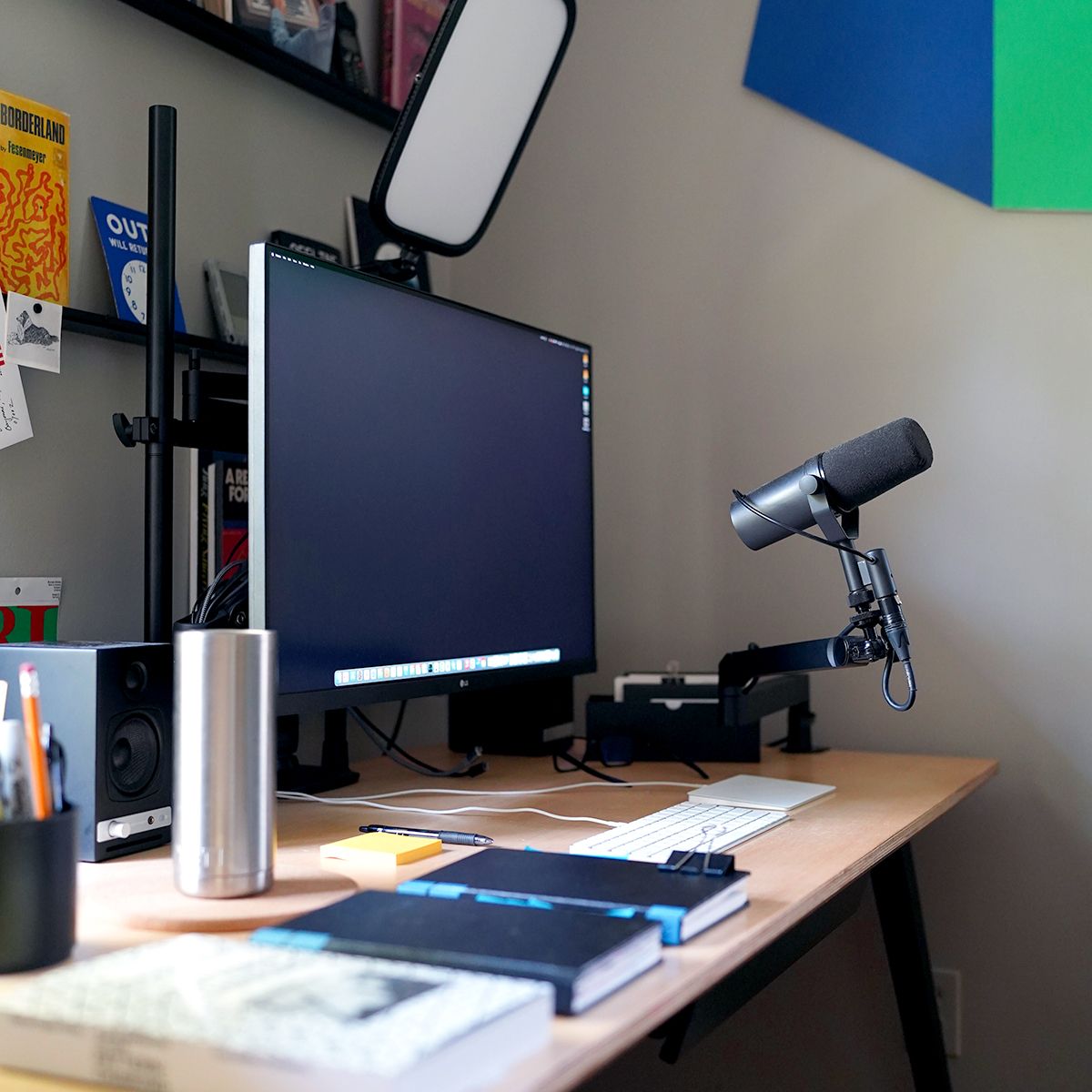

On the desk is:
Underneath the desk I use a simple rack on wheels to stack two computers, an input hub, three different external storage drives, an audio interface, a battery backup and even my old minidisc player. All of it is humming all day, but out of sight.
All the lights, knobs, and buttons are irresistible to my nearly two-year old son, so I made custom covers out of half-inch black foam board that slide in between the rack’s supports and the shelf contents to keep him from exploring. You can see how they look on the right side of the split image below — covers out on the left, in on the right.
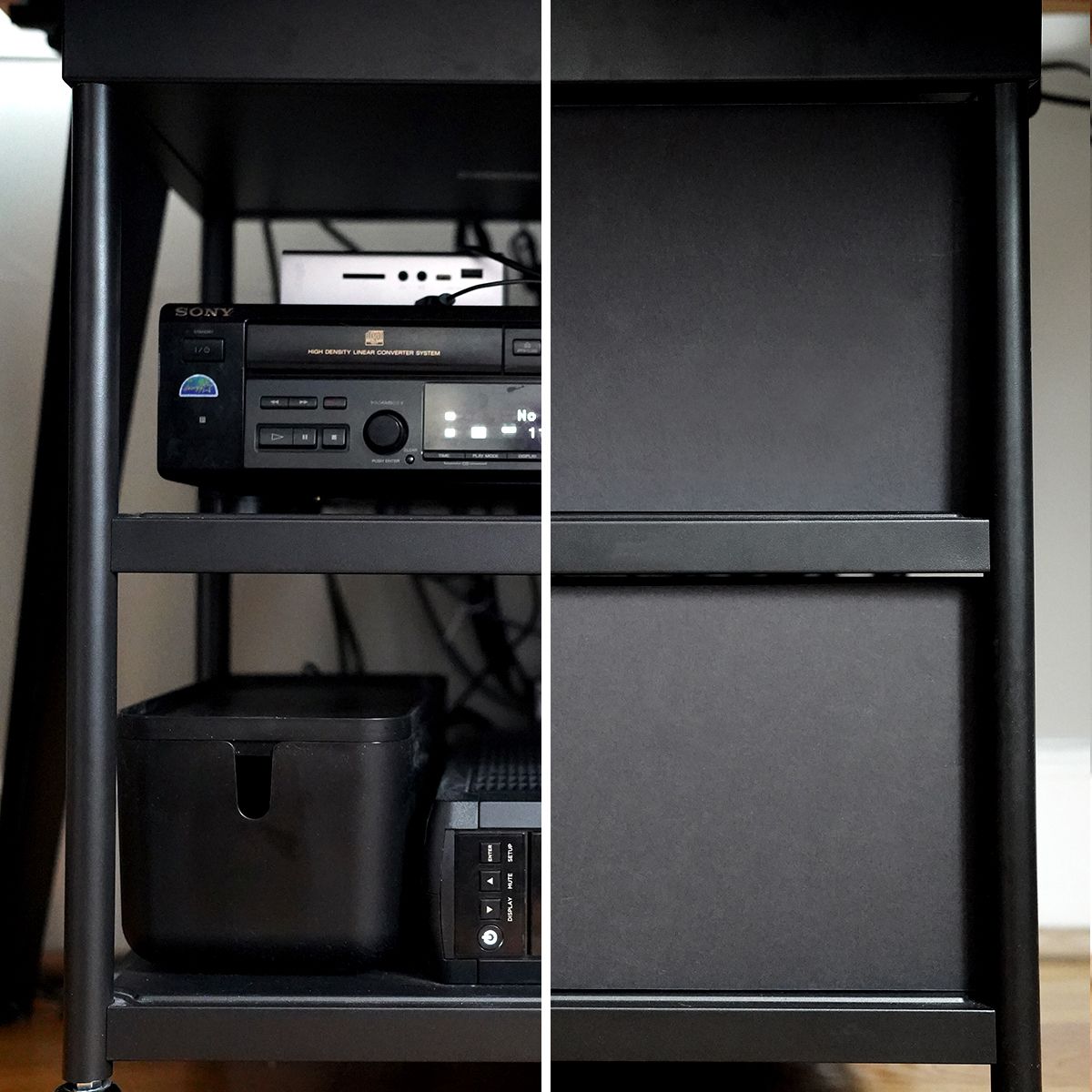
While I’m here, let me take a moment to urge those who have not to acquire an uninterruptible power supply (UPS) system.
We have two CyberPower CP1500 backups running in our office. Each has six battery backup and surge protected outlets as well as six additional surge protected outlets, network inputs, and USB inputs. (It’s the thing on the bottom shelf peeking out a bit from behind one of my covers.)
Just this week, we had a freak storm descend upon our city and in the span of just 35 minutes knock out power for hundreds of thousands and fell more trees than any other storm I’ve experienced in the time I’ve lived here. Because I do my work on a Mac Mini, having a UPS that kicks in when the power goes out saves me from losing work. But it can also keep the lights on, fans going, music playing, the works.
Keen eyes will notice that the cables behind everything are relatively tidy. The thing about cables is that the greater they are in number, the more difficult they are to tame!
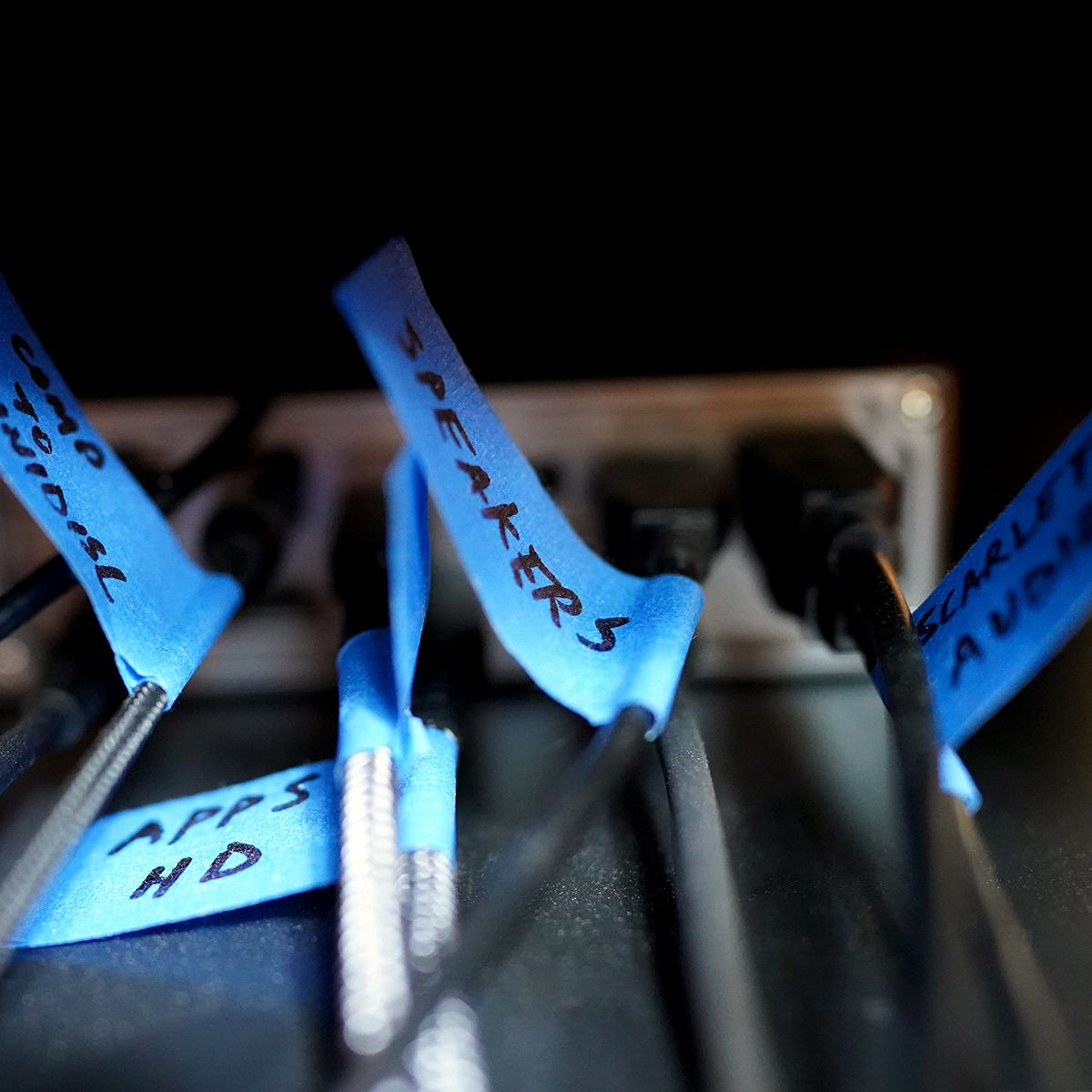
Rather than completely hiding them — and making it more difficult to access or alter them later — I prioritize labeling. I coil and bunch any excess cable, but I don’t clip or enclose them. I do label them at both ends so I can easily identify what’s what no matter where I’m looking.
Every time I find myself writing a label with sharpie on blue tape, I know I’m doing my future self a favor.
Under the desk is:
an IKEA KORNSJÖ side table two Apple M1 Mac minis a CalDigit Thunderbolt Station 4 hub two DIY External SSDs — using ACASIS 40gbps Enclosures, WD 1TB NVMe SSD Solid State drives, and 4’ Thunderbolt 4 Cables a LaCie 2big RAID 8TB External Hard Drive a Cloud Microphone Cloudlifter a Focusrite Scarlet 2i2 audio interface a Sony MXD-D40 a CyberPower CP1500PFCLCD UPS System- On the Walls
My wife and I keep a lot of books and magazines. We’re by no means at a hoarder level, but we do like our printed media and that takes up space. We have most of our library in another room, but in here, we have many magazines, all our design books, and all my books about the paranormal and other weirdness.
To keep them organized, we need shelves. I have found that the best shelves are the ones you create yourself.
Other than the racks under our desks, all the shelves in this room — there are many — were made by measuring and hanging custom rack or ledge shelving. It’s inexpensive, very strong (by god use a stud finder), and requires very few tools. I made mine with steel racks, half-inch poplar, a hand saw, a level, a pencil, and a few different straightedges.
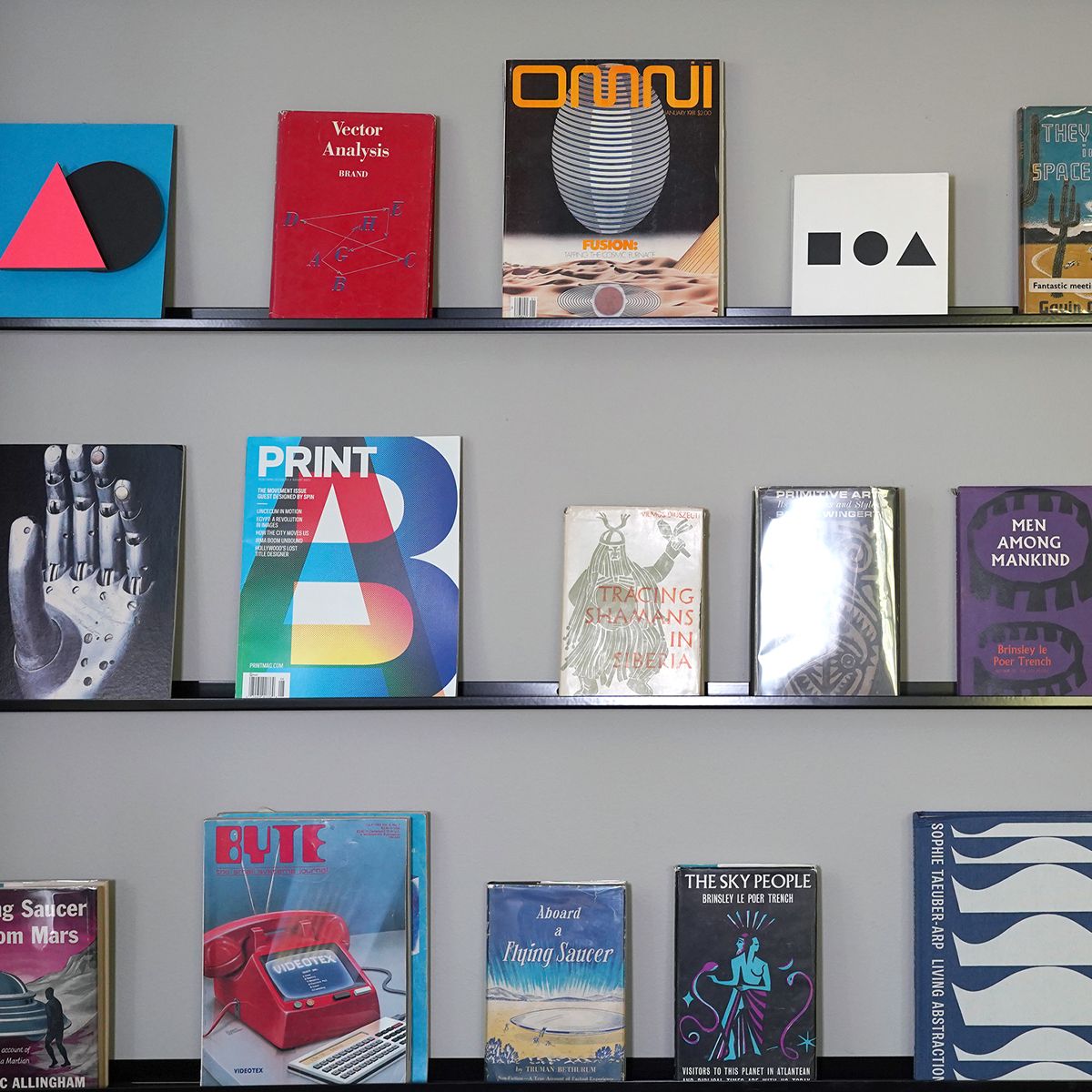
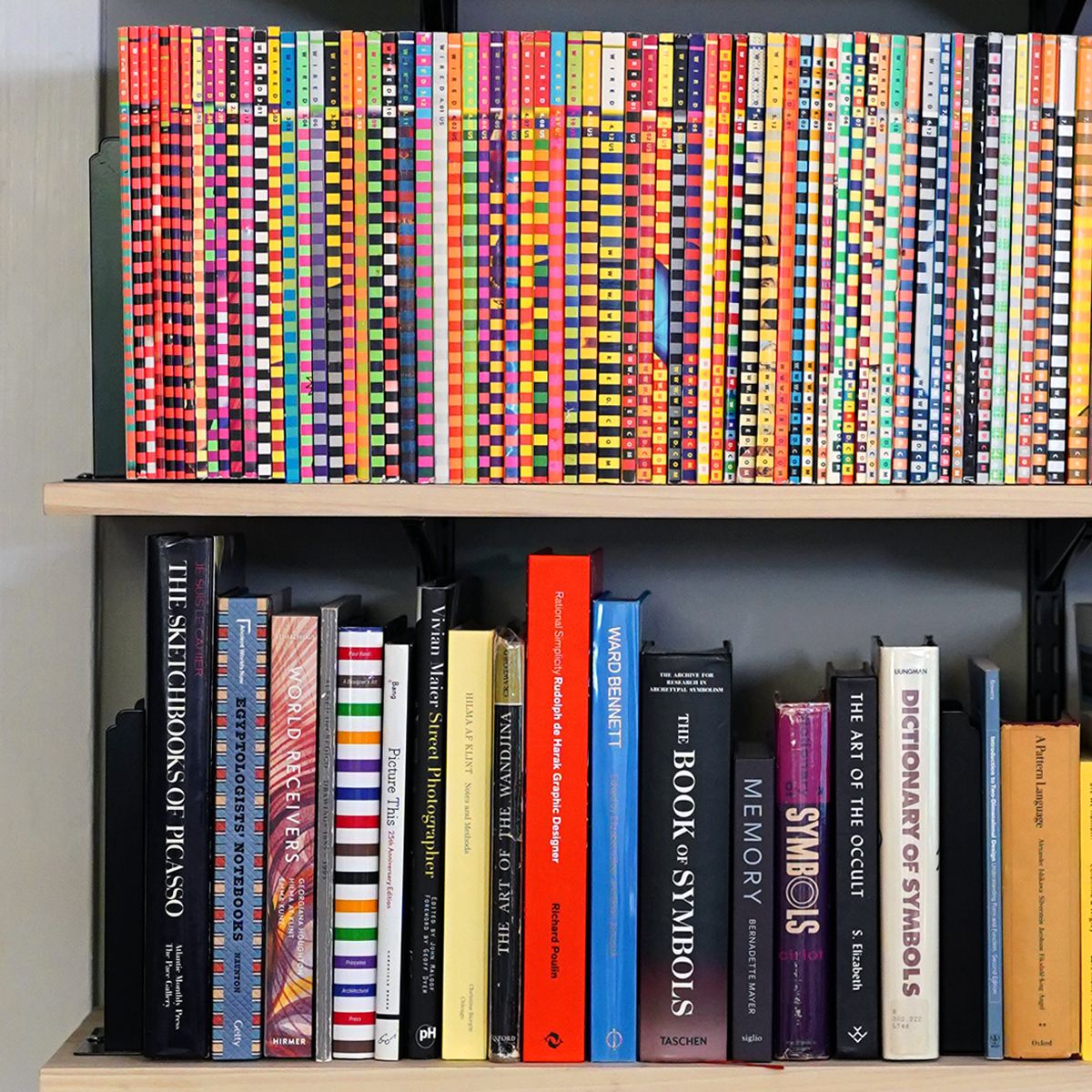
I strongly recommend library-grade bookends, which you can see at the edges of the shelf pictured above. These are the kind that won’t tip over, won’t bend, and won’t slide off the edge of floating shelves. They are very, very good.
Most of the stuff we keep on the shelves needs to be easy to retrieve. The best way to do this is to create kits. Find a container that works best for you in multiples and gather like items, put them in, and label them clearly. (I like the iDesign 29847, which was designed to hold toilet paper.)

The shelf pictured above has nearly every frequently used office or creative supply in our home. Each box is large enough to hold quite a bit, but small enough to be manageable by our kids.
This room also has a closet. I lined it with shelving to store household supplies, paper, tools, and emergency equipment and to make it easy to retrieve anything without having to root around. Most of this stuff is also in kits stored in IRIS USA Weatherpro latching boxes. We are ready for a disaster!
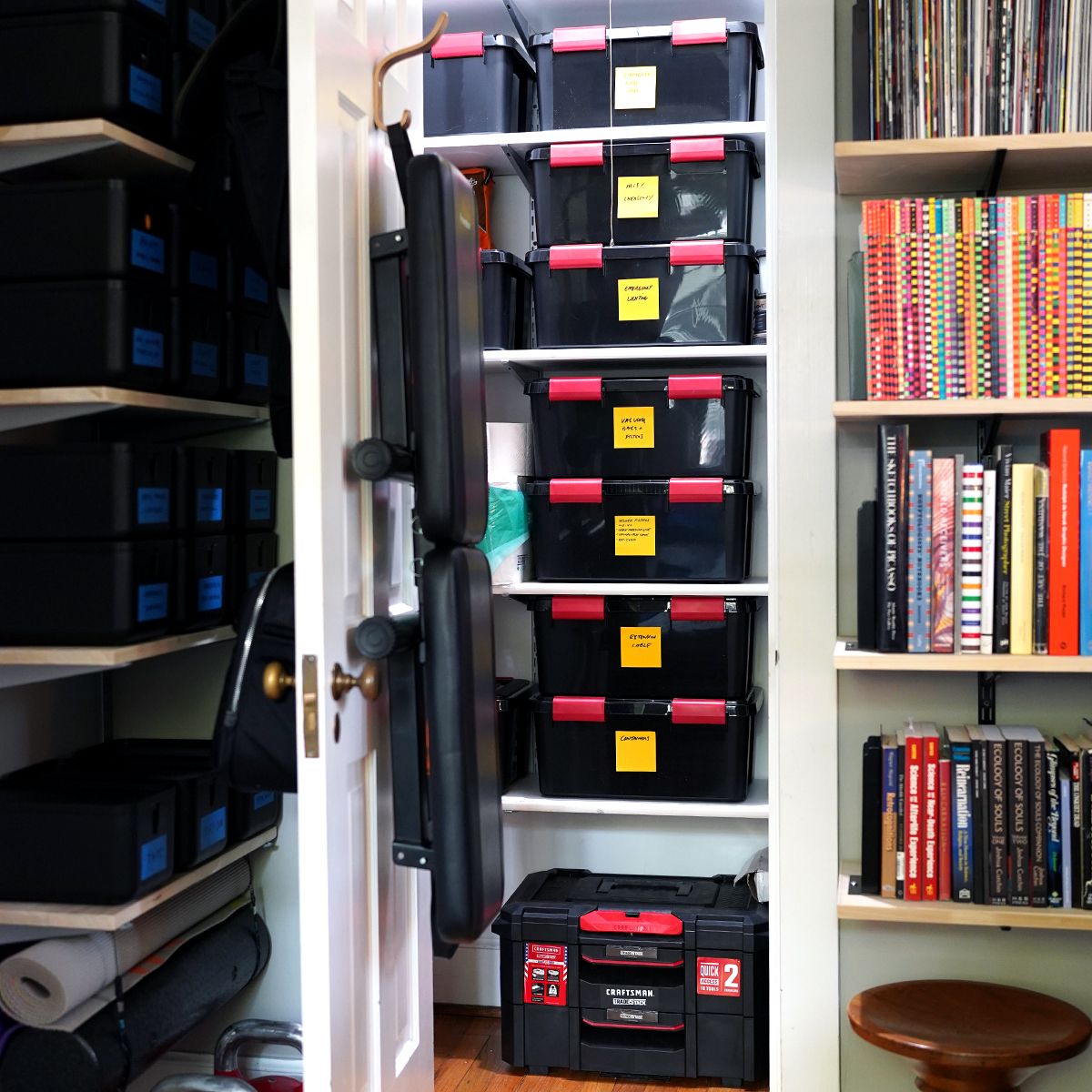
I’m particularly pleased that I can store a collapsible exercise bench on the inside of the door.
Other exercise equipment, like my kettlebells, sit under the supply shelving on the left — I even rigged up cables to hang rolled up yoga mats under the bottom shelf. 👌 It’s the little things.

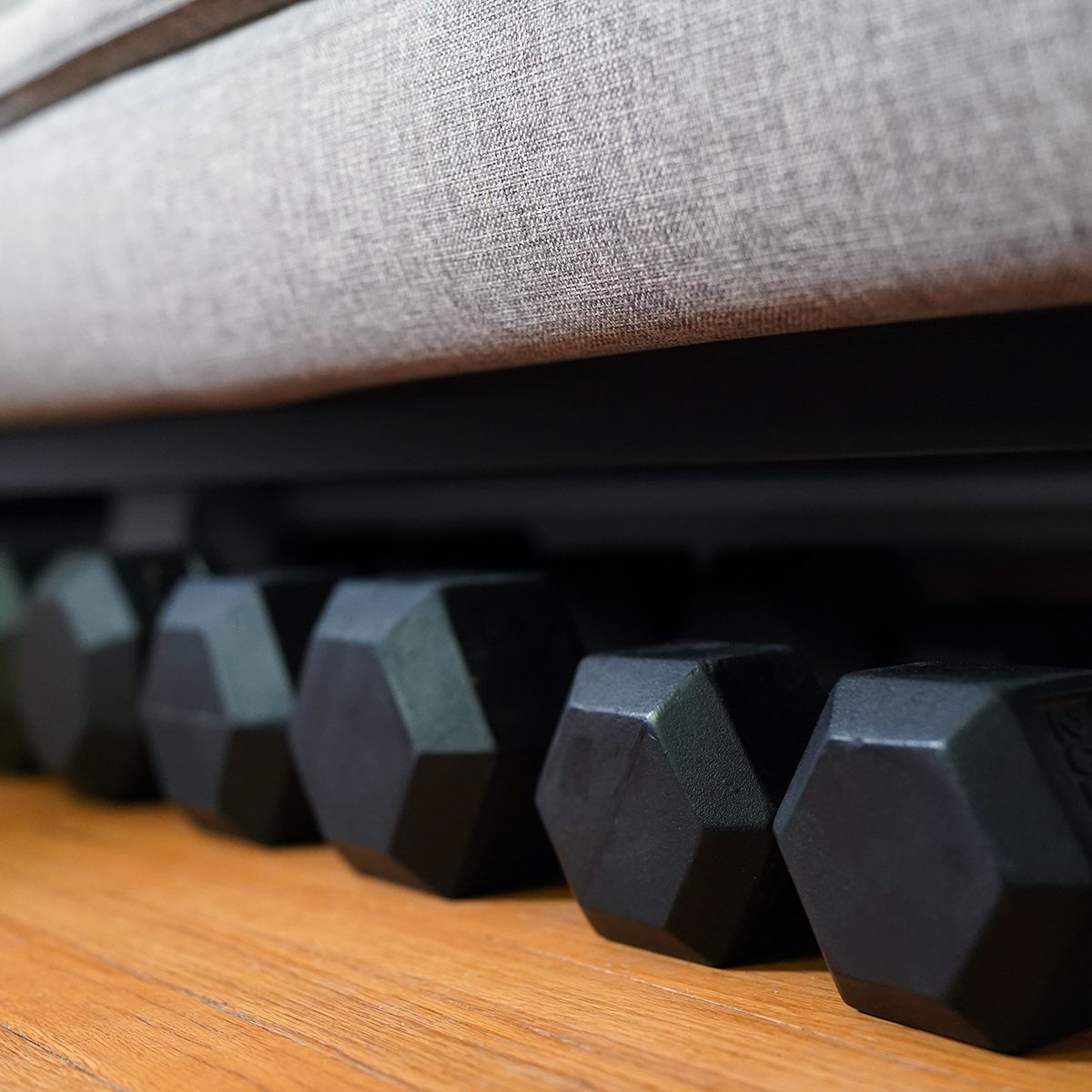
I keep my dumbbells in a neat line under the sofa/guest bed.
Good organization optimizes for storage and retrieval. These things are all very helpful:
- In Books
I’m as obsessive with how I organize information as I am objects and spaces. At this point in my life, I’ve tried dozens and dozens of digital organization tools. While I used some of them for a long time — I used Todoist for several years — none have ever felt as useful to me as pen and paper.
I’ve kept a notebook of some kind — as a sketchbook, an art journal, a log — for decades. I mostly maintained one at a time, and so there was always a mixture of things in it: notes and lists on one page, drawings and collages on the next.
But over the last few years, I’ve been formulating a more intentional and systematic use of my notebooks. Now, I maintain two books at the same time: one for visual exploration and the other for note-taking and list-making.
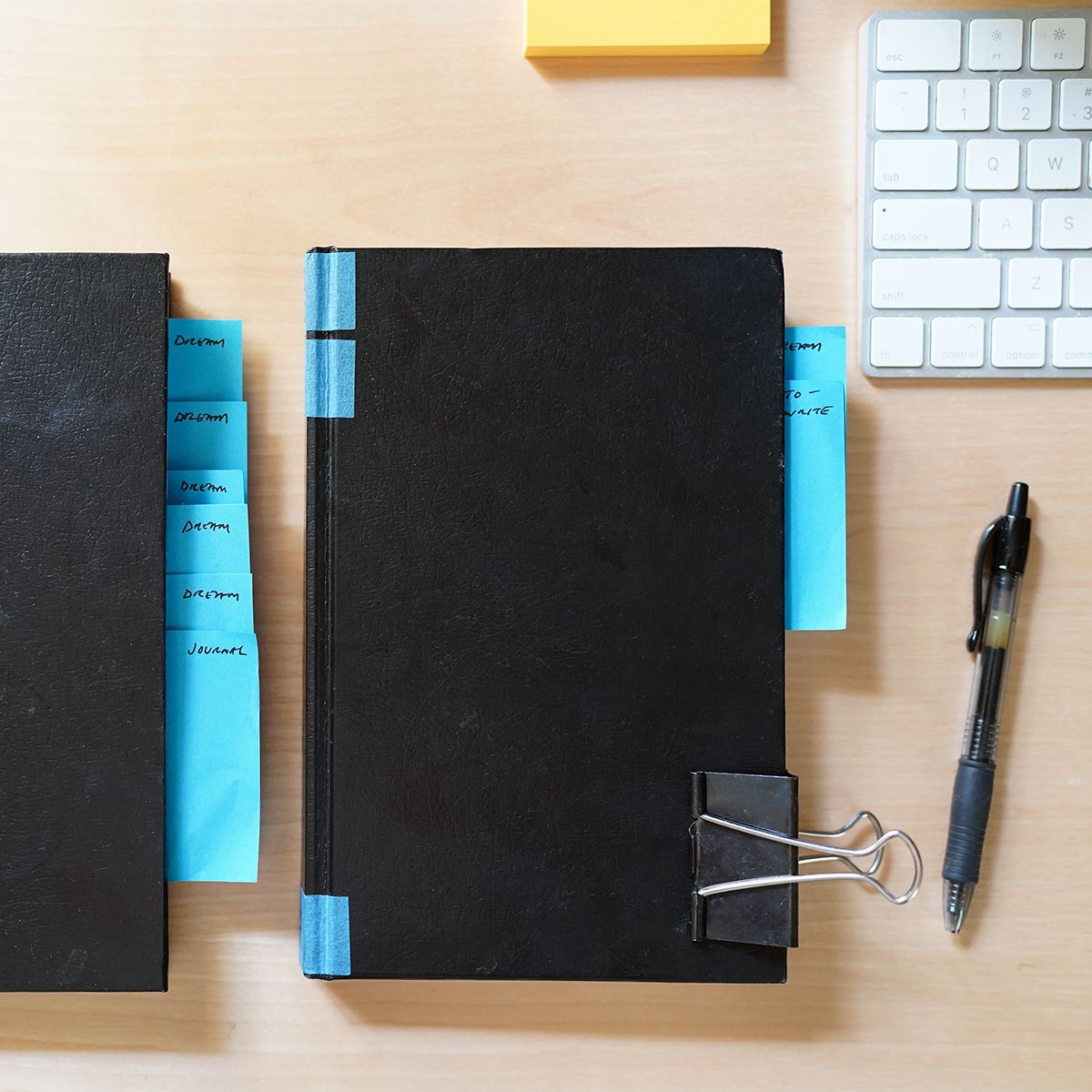
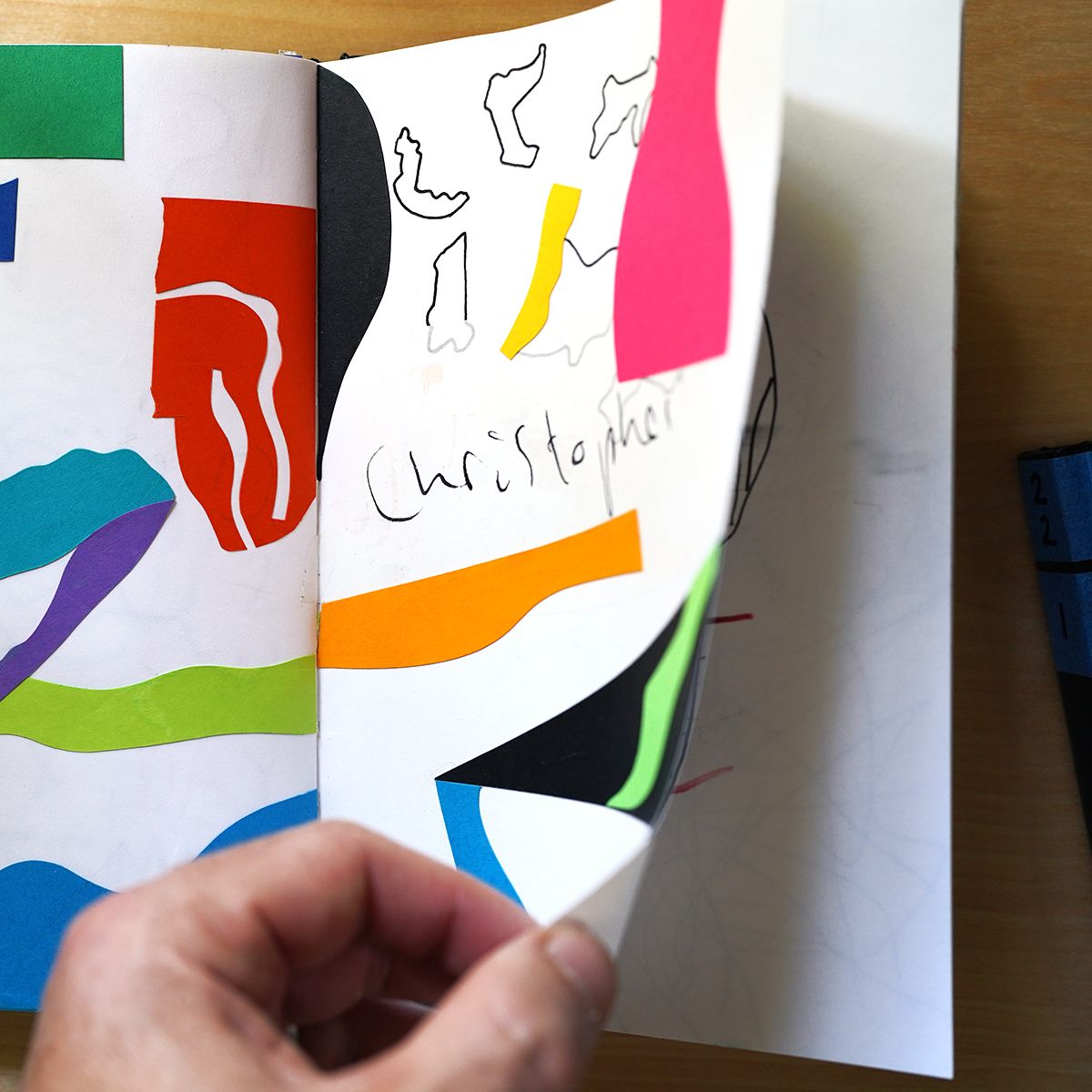
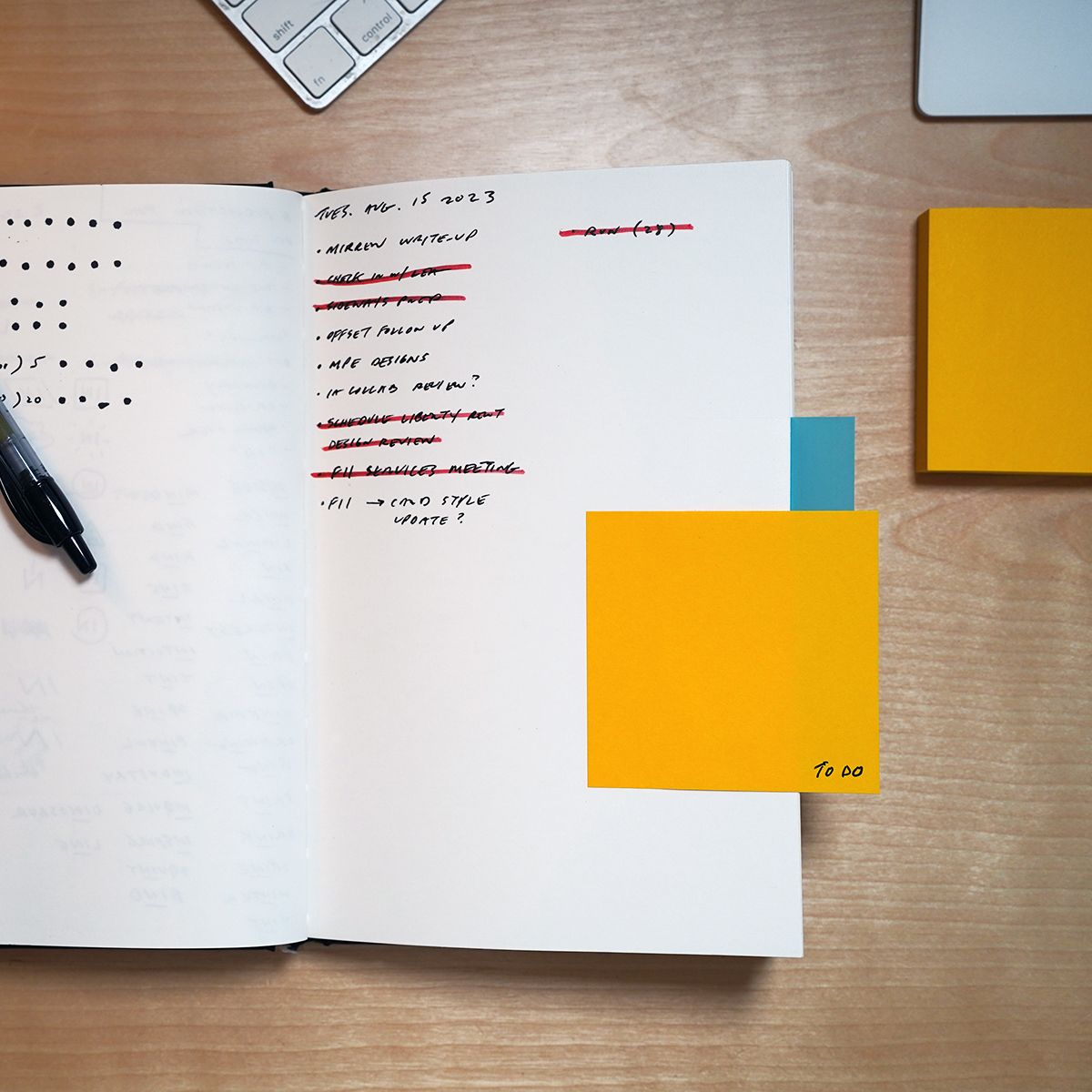
Just having two books helps, but the key to making this work as a productivity system is to maintain a specific habit of use. While I do find writing to-do lists on paper inherently better — for me — than using some kind of digital app because I can focus on the information outside of the digital space, it’s how I use them that makes them actually deliver results for me.
Here’s how it works:
-
I end the day by making a to-do list for the next one.
This is probably the most important work/life hack I can offer to anyone who doesn’t already do this. It’s a great idea to start your day with a prioritized list of the things you need to do. But I end my day by making that list so that I can also use it as a tool for clearing my mind and letting me make a meaningful mental break from work. I have also found that when my days are very busy, if I don’t end them with making a list for the next day, I am likely to forget details by the next morning. This is especially true if I let my inbox determine my day; if I don’t have a to-do list, my inbox becomes one. -
I mark my to-do list with a bright, yellow sticky note.
This is a very small detail, but it lets me shut my notebook and set it aside. The next morning, I can open it directly to the day’s list. Then I move the sticky note to the next page. When I am stressed, tiny investments in my future self really pay off. Giving myself an immediate sense of place is one of them. -
If a task is longer-term and has many sub-tasks, I create an index card to contain it.
I might transpose some of the sub-tasks from the card to my book so I can keep track of things in one place throughout the day, but doing this lets me think through how I’m going to achieve a larger goal over a longer period of time. I keep these index cards in a small box on my desk. -
There are no analytics, and that’s a feature.
Back when I used Todoist, I found its analytics intriguing and motivating. I initially liked being able to pore over my productivity statistics. And Todoist set it up to “reward” you as you completed more tasks. Ithink I worked my way up to some absurd number of tasks complete, which the app always displayed front and center, and some ridiculous classification like “Master Overlord” or something. It worked for me, until it didn’t. Analytics in this context create their own layer of stress. I’d find that if my numbers dropped, it felt wrong, even if that was because I was less busy — which is probably a good thing now and again! I found that I was thinking about my “performance” as often as my productivity. I didn’t need that.

This is what works for me. I’d never assume it would work for everyone, or that everyone would have the same trouble with an app like Todoist that I eventually did. But if you’ve tried apps of various kinds and still don’t feel the benefits of organizing your work, I’d suggest taking it offline. One point of a system like this is to help you get things done. The other is to help you feel more at ease.
Now, this doesn’t mean I never use a computer for notes and lists. If I write a note or have an idea that I want to transpose to a digital file so that it can become something else — like an article or a message to someone — I use a blue post-it note to mark it and keep it there until I’ve copied it over. (Many of my blue bookmarks are for dream entries that I like to store digitally so I can search them later. Maybe I’ll write something on dream journaling some day…)

These timeless office supplies are very useful to me and I don’t want to live in a world without them:
Why, though?
I am on a continuous quest for organization.
For most of my life, order has been something of an obsession. Everywhere I look, I see chaos and entropy creeping in. I see a new surface and anticipate wear and tear. I see a functioning system and look for where it will break.
That may sound like an exaggeration and more than a bit unpleasant, but I’ve come to understand that it’s neither. Life is, paradoxically, both order and disorder.
The very possibility of life presumes order — the coherence of biology at the atomic level — and yet, the act of living tends toward disorder. As we live and breathe and move about this world we and it push and pull against one another; words against wind, towers and tides, edifice and erosion. Given the broadest and longest view, all created order is futile. We simply don’t live long enough to maintain it.
But zoomed in, at the closer range of living day by day, created order is, literally, the fabric of functional living. Roofs are order. Clothing is order. Order puts food on the table.
I find the challenge of creating and maintaining functional systems, well, kind of fun. It is a creative act. And, it never ends. No system can last forever, and no system should. Situations change, needs change, we change. So the things we depend upon to exist well need to change, too. That means we have to continually look for things to make and ways to optimize them. That sounds good to me!
18 August 2023
Recommend
About Joyk
Aggregate valuable and interesting links.
Joyk means Joy of geeK